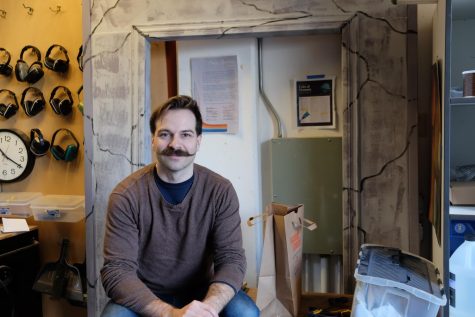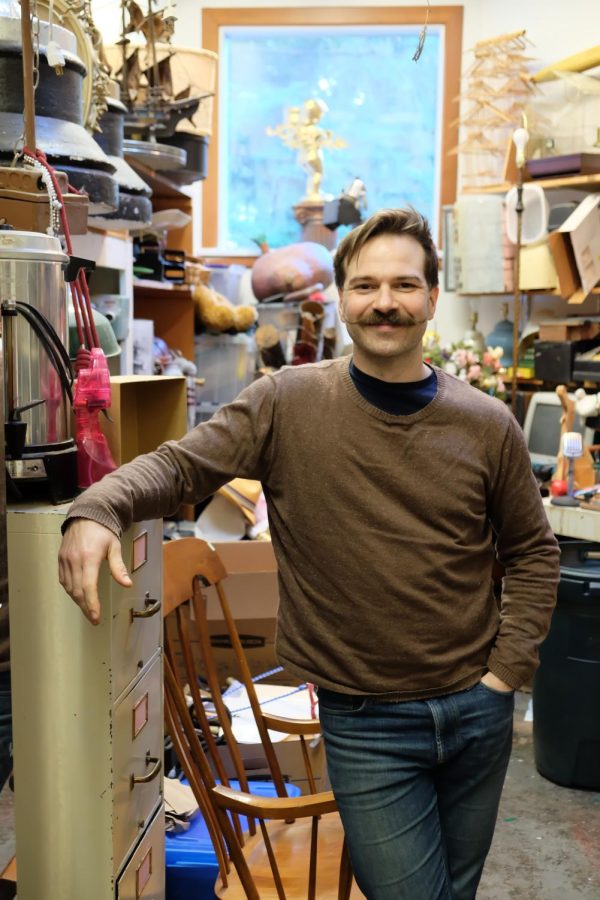Lakeside Theater Set(s) to Move Towards Sustainable Solutions
After three nights of adrenaline-fueled performances and microphone mishaps in a buzzing St. Nick’s theater, “Les Misérables” director Micky Place found pulling the musical’s set apart the following Monday therapeutic. “It feels like going downhill after a hike,” he says of the set strike. “Going up that mountain is so much more work — it takes weeks and weeks and weeks.” In addition to directing, Mr. Place designed and constructed the set with his Theater Production class and Sergio Vivas, a professional carpenter. Dismantling archways and metal railings allows Mr. Place a sense of closure — an emotional “decrescendo” — to one of Lakeside’s most ambitious productions in recent memory, a three-month process made especially meaningful by the show’s theme of hope amidst social upheaval.
Then, after the stage was left bare, faint etchings of set pieces in the dust, Mr. Place faced the decidedly less therapeutic task of determining what to do with a small mountain of disassembled theatrical scenery. The most convenient strategy most years: throw the entire set away. But this year, he came with a different plan.
In contrast to last year’s “Matilda,” in which almost the entire set — including 12 desks Krazy-glued together to form a platform, a 10-feet tall bookshelf facade, and multiple doors and stair units — ended up in a dumpster behind St. Nick’s, Mr. Place estimates he threw out less than five percent of the elaborate architecture of “Les Misérables,” repurposing materials for future shows. The change marks the beginning of a new theater production design process which Mr. Place hopes will thrust environmental sustainability into the spotlight without sacrificing artistic expression or show-stopping sets.
It’s a banana, it’s a gun, it’s a phone.
Sustainable theater, it seems, is something of an oxymoron. Much of theater’s magic lies in its ephemeral nature — its ability to grow into something fresh and singular with each production, even each night. Lakeside shows are especially fleeting, running for only three nights. Sustainability, on the other hand, aims for consistency and reuse. How can a theater artist striving to reduce waste reconcile these two truths?
Mr. Place began grappling with this question about a year ago, when he began considering the environment his young children would inherit and how they would view the waste their family created in their childhood. Examining his practices in his personal and work life — especially as someone without an environmentally-focused occupation hoping to make an impact — he developed a philosophy around sustainability.
Instead of viewing environmentalism in our daily lives as “sustainability dieting,” — recycling here and there, occasionally taking the bus — Mr. Place believes in redesigning practices such that convenience is synonymous with sustainability. In other words, environmentalism has to be personally sustainable, integrated seamlessly into our lives and aligned with financial incentives.
For the theater department’s new production design process, Mr. Place thinks in the long term about each set piece, reducing not only wasted material but excess expenses. Rather than creating more platforms of Krazy-glued chairs, unusable for any other purpose, Mr. Place has begun mapping out production cycles in advance, designing set pieces for longevity by considering their dimensions and potential uses.
Mr. Place stores all scenery in a quickly filling semi-trailer behind the WCC. “We’re not holding onto any set piece for nostalgia — all of it is for practicality,” he notes. Much of the materials Mr. Place gathers comes from second hand store Second Use Building Materials, another way in which his financial and environmental considerations converge.
Environmentalism has to be personally sustainable, integrated seamlessly into our lives and aligned with financial incentives.
But this new philosophy doesn’t mean the theater department won’t build new set pieces, or that scenery will feel stale from show to show, Mr. Place says. “The reinvention of objects, the reinvention of space, the reinvention of time are at the core of the theatrical practice,” he says. “It’s a banana, it’s a gun, it’s a phone.” Reusing set pieces multiple times allows for artistic exploration and reimagining, something he realized while helping to design the set for the fall production of “A Midsummer’s Night Dream” alongside director Alban Dennis. A ramp used as a gathering place for fairies could be later converted into the doorway to heaven for “Les Misérables” and, most recently, as a feature of the Middle School’s “Xanadu” through repainting and restaging.
In professional theater communities, most companies similarly have a large inventory of stock scenery to reuse, sometimes even sharing set pieces with other theaters after wrapping a show. According to Joan Toggenburger, the director of production at 5th Avenue Theatre, the theater owns a warehouse where they store much of their stock scenery — often steel components which are the easiest to reuse. But the team is limited in what they can keep due to maintenance and storage costs: “There’s a lot involved in storing scenery. Space is at a premium — especially to be close to downtown.” For the 5th Avenue’s production of “The Wiz,” which closed on December 23, Ms. Toggenburger estimates half of the set was stock scenery, while the other half ended up in the dumpster. Ms. Toggenburger also notes that scenery is only a portion of the environmental impact of a production; costuming and the energy required for lights and sound play a significant role as well.

For Mr. Place, environmental concerns pile on to an already demanding task of directing over 80 students in the cast and crew of the musical each year — all culminating in three free performances. But Mr. Place’s belief in theater, in its ability to sustain meaning and truth, hasn’t wavered. “It does feel like climbing a mountain, where it’s like, ‘why do it?’” he says, a smile growing. “It’s there and it’s awesome, it’s beautiful, it’s full of magnitude. So we do it.”
Don't let the name fool you; Stellan Will do the Max, which is also his name (and is preceded by that of his brother). He's a Mountain Man, he's a Lakeside...


